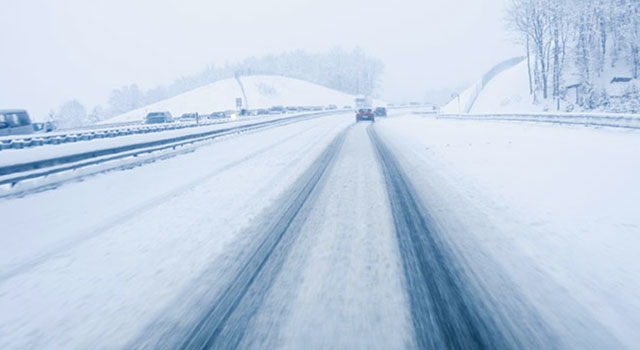Navigating icy roads can be a challenge, and a situation where your car starts sliding can be scary. Preparing your car and understanding what happens when your vehicle loses traction can help you stay calm in the event of a slide. Here’s what to do if your car starts sliding on ice, and what you can do to prevent and correct it.
How to prevent your car from sliding on ice
The best way to prevent your car from sliding on ice is to avoid driving in the first place. If you must go out, exercise caution and follow these safety tips to prevent your car from sliding in the snow and ice.
Go slowly
Take it easy when you’re driving in the snow. No amount of time saved is worth your safety and well-being. Plan for your trip to take more time and leave earlier. Keep at least double the distance from other vehicles than you normally would. This gives you more time and space to slow down or stop.
Maintain visibility
Keeping your vision clear helps you spot hazards as soon as possible, and gives you more time to react. Clear off all snow and ice from your car before you head out. Make sure your windshield is defrosted and clear, as well as your other windows. Make sure your wipers are in good shape. It may be time to replace them if they’re leaving streaks. Winterizing your car can help prevent ice from forming on your wipers and windshield while you’re driving.
| Furnaces |
|
Keep your tires in good shape
Make sure your tires are in good shape and have enough tread left. It is dangerous to drive on worn or old tires, as what little grip you do get from them is further reduced by the snow and ice.
Consider switching your tires to winter tires for the season. Winter tires are designed to have improved grip in the snow and ice. However, you should still take it slow even with dedicated winter tires.
Low gear
Driving in a lower gear may help you maintain traction on the road and avoid wheel spin. In most automatic cars, you may see settings on your gear selector below “D” labeled “3” and “2”, or just “L”. Some cars have a Manual (M) or Select (S) setting that lets you choose a gear to drive in.
Using a lower gear prevents you from driving too quickly, and helps you maintain traction as you’re driving. Lower gears also have the benefit of slowing you down when you let off the throttle pedal, allowing you to reduce your speed without having to brake too suddenly.
No sudden movements
When driving in the ice and snow, avoid making sudden movements with the car. Don’t jerk the steering wheel, as this can cause you to lose control quickly. To avoid skidding or having your brakes lock up, apply light pressure to the brakes. Again, leave plenty of room between yourself and the car ahead of you.
Avoid side streets
When driving in the snow, try to avoid driving on side streets that have not been plowed or salted. Even just a few inches of snow can cause you to lose control of your car.
What to do when sliding on ice
If you do find yourself in a situation where your car is sliding on ice, keep the following in mind to safely regain control. This information does not guarantee you’ll avoid an accident- the only tried and true way to prevent your car from sliding on ice is to stay off of the road.
Don’t panic
You can correct a skid, but only if you remain calm and feel how the vehicle is moving. Don’t make sudden, jerky actions like slamming on the brakes or turning the steering wheel.
Don’t slam the brakes
It seems only natural to hit the brakes when something adverse is happening to your car. In the case of a slide however, hitting the brakes too hard can make the situation much worse. Instead, lightly and slowly apply the brakes.
When the road is slippery, your brakes may make a loud grinding or pumping sound when you press on them. This is normal if your car has an anti-lock braking system (ABS). What’s happening is your car is releasing and re-engaging your brakes rapidly to maintain traction. Don’t panic if this engages! It may sound like something is getting damaged, but this is the system doing its job.
Correcting a slide
If you’re sliding sideways, turn the wheel in the direction the back of your car is going. For example, if your car is sliding out to the right, you’ll want to steer to the right. Avoid over correcting by steering gently, and apply light pressure on the brakes if you have to. If there are other cars or pedestrians, sound your horn to warn them.
Now let’s talk about you
Do you have the right coverage for your vehicle? We’d love to chat with you about it. Call us at 800-516-9242 or speak to a local agent.
If you’d rather not talk, you can get a quote quickly and easily online. Just enter your ZIP code to get started and see how much you could save!

